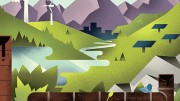The Manitoba Hydro Bipole III east vs. west debate has being dragging on now for years. Bipole III is an electrical transmission line meant to transport electricity — that stuff you use every day power things like your stove (so you can cook), your dryer (so you can dry your clothes) and your computer (so you can masturbate). The electricity begins its life on Nelson River near Gillam, Man. and ends up in places other than Manitoba such as Saskatchewan, Minnesota and North Dakota.
The main argument from those on the right of centre is it costs too much to build Bipole III west of Lake Winnipeg — possibly twice the original $2.2 billion — and that eastern area is not as “pristine” as the left claims. The main argument from the left is that a high voltage direct current line built on the east side will destroy the pristine boreal forest.
Both these rudimentary arguments seem compelling. The adult in me likes money and wants to be fiscally responsible, but the kid in me doesn’t want to go camping under power lines. Together let us examine the issue in some depth and with some clarity; let’s get all the facts in the mixing bowl.
Pros of west-side route are that it will save about 4.3 million hectares of intact boreal forest on the east side, leaving untouched pristine hunting/fishing grounds, camping sites and one of the world’s largest carbon storage sinks while maintaining biodiversity. The west-side route doesn’t piss off roughly five First Nations, as some First Nations on the east side have nominated their traditional territories to be incorporated into a UNESCO world heritage site. This route also pleases the provincial governments of Manitoba and Ontario, as well as American environmental groups. On top of this, the west side is more stable ground from an engineering standpoint, in that the east side has large amounts of bog, which would be rather hard to build on or around. A west-side route leaves Manitoba/Ontario with the ability to promote a UNESCO world heritage site — an eco-tourist’s dream destination — and any subsequent spinoffs that might arise from the designation.
A major strike against the west route is that it costs more. According to Manitoba Hydro, the extra cost runs about $2 billion, or $3-4 billion in total, according to a leaked Manitoba Hydro document obtained by the Canadian Taxpayers Federation. A west-side Bipole III pisses off affected residents, mainly farmers, who feel they haven’t been fully informed of development or potential health effects. Also, with the longer transmission line on the west side there will be excessive energy lost (referred to as “line loss”) in transmission from up north to markets in the south.
Professional opinions from engineers and politicians claim that the excessive costs along with the large line loss of the west side makes it an irrational choice. On the other hand, First Nations and environmentalists wish to protect the boreal forest, which protects the environment by acting as a carbon storage sink.
Here’s where we get into externalities, triple bottom line accounting and corporate social responsibility. The boreal forest stores carbon. If we start removing parts of the forest we release more greenhouse gases into the atmosphere, thus adding to global warming, climate change, catastrophic climate destabilization or whatever it’s called these days.
How are we to account for such externalities? If we build down the east side and destroy nature’s filter, should we spend the money we save on other carbon reduction methods like planting more trees, which after removing many to build the Bipole would seem kind of ironic?
The point I want make is yes. The west side costs more from a strictly monetary standpoint. However, the east-side option may cost more in the long term when we allow a carbon storage sink to be destroyed.
There’s a provincial election on Oct. 4, 2011, and the Bipole debate is sure to be an issue. So, go out and educate yourself, form an opinion on the issue and have your say.
D’Arcy McDougall is a fourth-year environmental studies student.




